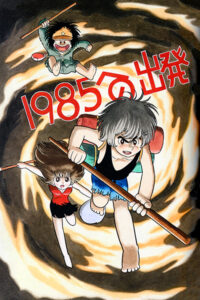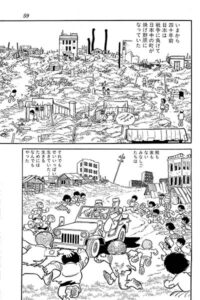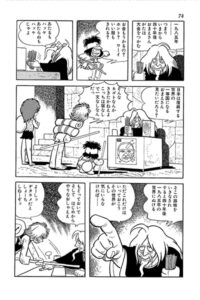Destination: 1985 (Manga)
also known as 1985への出発 (1985 E no Shuppatsu)
| English Title: | Destination: 1985 |
| In English? | No |
| Japanese Title: | 1985への出発 1985 E no Shuppatsu |
| Type: | Short Story |
| Original run: | 1985/07 |
| Published in: | Monthly Shonen Jump 月刊少年ジャンプ |
| Published by: | Shueisha |
| Volumes: | 1 MT-325 |
The short story Destination: 1985 (1985) was originally published as a short story in Monthly Shonen Jump, in July 1985.
What it’s about
In 1945, just after the end of World War, three young orphans, Kazuo Tanaka (age 13), Kimiko (age 17), and Tetsu (age 6) are rounded up by the authorities and are taken to an internment camp for children. Kazuo masterminds a daring escape for himself and his two young friends and then leads them back to his “home” – an abandoned air raid shelter.
Although life on the streets is tough, Tetsu shows his worth by gathering food for the group – by begging or stealing as the case may be, while Kimiko takes on the task of assembling clothing. Although they try to be settle into their new life, when they discover a frail old man also hiding out in the air raid shelter, Kazuo’s first instinct is to throw him out. However, Kimiko’s kind heart gets the best of her and she takes on the responsibility of feeding and caring for the old man.
In the morning, when the trio awake, they find the man has already left. Of course, they don’t have time to investigate because Tetsu brings a warning that American soldiers from the occupation force are clearing out old Japanese military installations. Although Kazuo tries to stand his ground, the soldiers trick him into leaving and the trio are once again, back on the streets. As luck would have it though, they stumble across the old man – who turns out to be a fortune teller.
As thanks for their kindness, he offers to read their futures – and he promises them they will find great wealth over the next 40 years. The young urchins are skeptical, so he magically sends them to visit the year 1985 to see for themselves – with the promise that if they don’t like what they find, they can come back and change it.
At first the three young children are overawed by the changes that have taken over Japan in the forty years since 1945, but they are dismayed to find children their age playing with toy guns. In fact, they see a level of violence in children’s toys that is simply unbelievable to those who have experienced the horrors of war first hand, so they decide to take the issue up with a prominent toy company.
Upon arriving, the children are shocked to find that the President of the toy company is in fact an older Kazuo, who is happily married to his long-time sweetheart, Kimiko, and that the Vice-President in charge of their most popular toy gun is in fact, an older Tetsu. The older versions defend their choices, saying that the kids will understand when they’re older. However, the kids are adamant that peddling violent toys is wrong.
As they return to their childhood in 1985, the trio decide to split up – lest the future they’ve seen come to pass – and decide to make better choices in their lives. However, with one last look at his friends, Kazuo tells them all that he’ll see them again – in 1985!
What you should know
As most fans will know, Osamu Tezuka had a strong anti-war sentiment – one firmly based on his own experiences – and one that he revisited many times over the course of his career. Destination: 1985 (1985) was published in the July, 1985 issue of Monthly Shonen Jump, which was more or less the 40th anniversary since the end of World War II.
Unlike some of Tezuka’s other anti-war stories, such as Zephyrus (1971) or Paper Fortress (1974), which have a much more personal take on Tezuka’s experiences during the war, Destination 1985 provides Tezuka with an opportunity to make a (then) present day statement on Japanese society and remind his audience not to forget the not-too-distant past. By using a time-slip story plot, he’s able to juxtaposition children who have lived the aftermath of war first hand, with the present day children who, with no first-hand memory of the war or its aftermath, a perfectly happy to glorify violence through their play. The children’s outrage at their own future-selves plays a dual role. On the one hand, it encourages his young readers to think about their own choices in life. On the other, it calls upon the adults who DO have that experience not to facilitate the desensitization to violence.
Stars Spotted:
-
- Marukubi Boon as “President Kazuo”
- Notaarin as “Vice-President Tetsu”






Leave a Reply